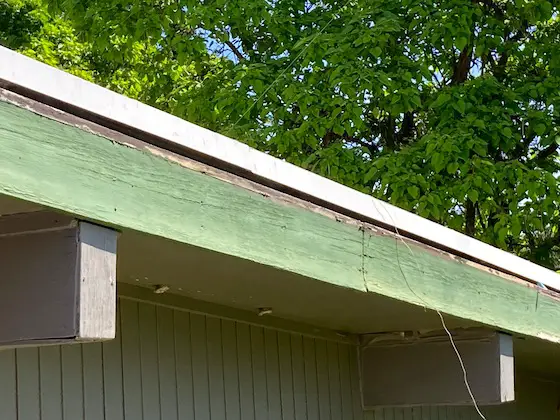Minimize Exterior Maintenance

Minimize Exterior Wood Maintenance - You may have exterior wood on your home that looks similar to this. There are several ways to minimize or eliminate maintenance of these surfaces. Copyright 2023 Tim Carter
How to Minimize Exterior Wood Maintenance
One of the things I enjoy most about writing my column is communicating with readers just like you. As often happens, a reader will visit my www.AsktheBuilder.com website and use the form on the Ask Tim page to get help.
Not too long ago Bob did this. He lives in Coeur d’Alene, Idaho, and reads my column in his local paper. Bob said, “I really enjoy your columns. Your practical knowledge and no-nonsense approach remind me of my father-in-law who was an architect and builder. He answered all my questions until we had to send him back to Heaven.” Bob mentioned that he was also an amateur radio operator like me. It’s loads of fun to hear from readers with similar interests!
Bob then went on to ask for my advice on how to replace his cupped and cracked 12-inch-wide wood facia boards with a more durable material. One of the dealbreakers was that he wanted to paint the replacement material to match the dark green color of his existing trim.
Three Possible Methods
Three different methods immediately popped into my mind. The least expensive method is to paint the existing facia boards assuming they’re still in fair shape. Bob did send two photos and the boards have seen better days. There are quite a few exterior spackling compounds and epoxy wood fillers that do a magnificent job of filling large cracks and holes. These materials can be sanded and they all accept paint. Cupped boards can sometimes be made flat using stainless steel screws.
Urethane House Paint
You may have had bad luck with paint in the past. Believe me, I understand that frustration. What would you say if I told you I know of an exterior house paint that can last 25 years if you simply apply it according to the simple instructions on the label? You’d probably think I fell and hit my head. I used this paint on my own home in Cincinnati in 1997 and it still looks as good today as the day I painted my redwood siding.
The resin component of the paint is urethane. Realize that paint at its most basic level is nothing more than colored glue. You want to use a paint that is ultra-sticky and urethane fits the bill. Visit a traditional national-brand paint store and you’ll discover that urethane exterior house paints can be purchased in any color and different sheens.
Wrap Facia in Aluminum Coil Stock
The second method I thought of was to wrap the facia boards with painted aluminum coil stock. Millions of feet of wood trim on houses has been covered in this manner over the past fifty years. My childhood home had it done in the 1960s. Aluminum holds paint exceedingly well and some coil stock comes from the factory painted a dark green color.
You can rent a metal-bending brake from a tool rental business. These simple machines allow you to make precision bends so the aluminum conforms to the shape of the facia boards. There are numerous videos on YouTube that show you exactly how to use a brake. It’s never been easier to discover how to do something. You can also watch other videos showing you how to install coil stock over facia boards.
Replace Facia With Plastic or Composite Trim
The most expensive and time-consuming method is to remove the facia boards and replace them with a non-wood material. Fiber cement is an option. I have fiber cement siding on my own home and a shed I built. You can paint it any color you prefer. While it has wood fibers in it, the cement prevents the boards from cracking, cupping or rotting like ordinary wood.
You can also use a plastic facia board. There are several brands. The only drawback with plastic is it has a very high expansion/contraction coefficient. The manufacturers caution that painting the material with dark colors can lead to catastrophic paint failure as the plastic material expands beyond the limits of the paint.
I have tested this material on my own home with great success. I had to replace my front door several years ago and used this plastic trim instead of going back with wood. This door faces south and doesn’t have any protection from the sunlight. It’s painted a fairly dark green and after six years the paint has not peeled. I did use the urethane paint and because it’s so sticky I feel that’s the reason the paint continues to bond to the plastic.
You can often avoid the expensive process of replacing wood trim by simply protecting it from the ravages of water. Water and wood trim don’t play well together. If your wood trim, siding, fencing, railings, etc. are in great shape, think about taking the time to do what I did with my house all those years ago. Get the urethane paint, read the label, and apply it exactly as directed. You may never have to paint it again!
Column 1524